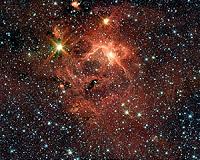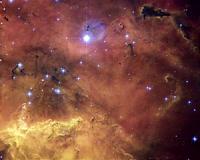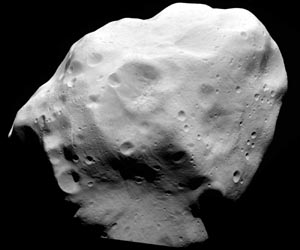|
 Astronomers Find A 300 Solar Mass Star
Astronomers Find A 300 Solar Mass StarSheffield, UK (SPX) Jul 22, 2010 Using a combination of instruments on ESO's Very Large Telescope, a UK-led international team of astronomers have discovered the most massive stars to date, one which at birth had more than 300 times the mass of the Sun, twice as much as the currently accepted limit. The existence of these monsters - millions of times more luminous than the Sun, losing mass through very powerful winds - may provide an answer to the question "how massive can stars be?" The new results appear in a paper in the journ ... read more |
. |
|
|
Free Space, Earth, Energy And Military Newsletters - Delivered Daily |
| . | . |
| .. |
Refining A Cosmic Clock Washington DC (SPX) Jul 16, 2010
Washington DC (SPX) Jul 16, 2010Physicists will soon have a better measure of the age of our galaxy, thanks to experiments described in a trio of papers appearing in the journal Physical Review C. The papers report on experiments at the CERN neutron time-of-flight (n_TOF) facility and the Karlsruhe Van de Graaff accelerator that clarify the processes that affect the abundance of the element osmium-187. The element ... more MESSENGER Spacecraft Reveals New Information About Mercury  Washington DC (SPX) Jul 16, 2010
Washington DC (SPX) Jul 16, 2010The first spacecraft designed by NASA to orbit Mercury is giving scientists a new perspective on the planet's atmosphere and evolution. Launched in August 2004, the Mercury Surface, Space Environment, Geochemistry and Ranging spacecraft, known as MESSENGER, conducted a third and final flyby of Mercury in September 2009. The probe completed a critical maneuver using the planet's gravity to ... more Record-Breaking X-ray Blast Briefly Blinds Space Observatory  University Park PA (SPX) Jul 15, 2010
University Park PA (SPX) Jul 15, 2010A blast of the brightest X-rays ever detected from beyond our Milky Way galaxy's neighborhood temporarily blinded the X-ray eye on NASA's Swift space observatory earlier this summer, astronomers now report. The X-rays traveled through space for 5-billion years before slamming into and overwhelming Swift's X-ray Telescope on 21 June. The blindingly bright blast came from a gamma-ray burst, ... more |
.. |
 All Stars Are Born The Same Way  Hubble Snaps Sharp Image Of Cosmic Concoction  Instant online solar energy quotes Solar Energy Solutions from ABC Solar |
.. |
|
|
Free Space, Earth, Energy And Military Newsletters - Delivered Daily |
|
|
. |
 Fascinating Images From A New World
Fascinating Images From A New WorldMunich, Germany (SPX) Jul 15, 2010 The ESA space probe Rosetta flew past the Lutetia planetoid at around 6 p.m. CEST on Saturday. The OSIRIS camera system, built and developed under the direction of the Max Planck Institute for Solar System Research in Katlenburg-Lindau, Germany, provided unique images of this rendezvous. They not only show a large number of craters on the surface of the celestial body, but also individual rocks and parallel grooves. With a resolution of around 60 metres per pixel, the images provide a fascin ... read more |
| The contents herein, unless otherwise known to be public domain, are Copyright 1995-2010 - SpaceDaily. AFP and UPI Wire Stories are copyright Agence France-Presse and United Press International. ESA Portal Reports are copyright European Space Agency. All NASA sourced material is public domain. Additional copyrights may apply in whole or part to other bona fide parties. Advertising does not imply endorsement, agreement or approval of any opinions, statements or information provided by SpaceDaily on any web page published or hosted by SpaceDaily. Privacy statement |
| Previous Issues | Jul 21 | Jul 20 | Jul 19 | Jul 16 | Jul 15 |